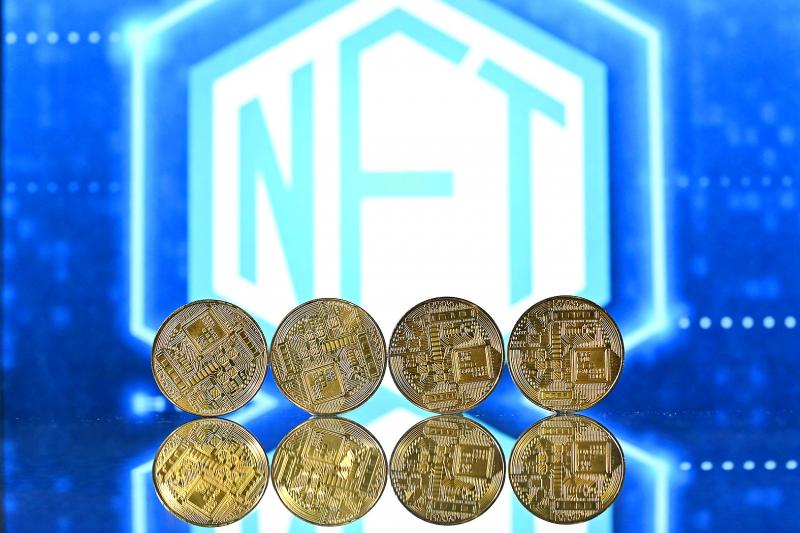Before he passed away in 2019, Dan Howard was a concept artist, working with major video game companies and posting his drawings online, where he had amassed a loyal fan base.
Late last year, an anonymous account online started auctioning off Howard’s work as non-fungible tokens (NFTs), a kind of digital asset often linked to an image or piece of artwork.
Howard’s family only found out about the sales when a fan alerted them.

Photo: AFP
“We felt like we’d been the victim of a high-tech grave robbery,” his brother Donovan, said.
Donovan emailed OpenSea, the NFT marketplace where his brother’s work was posted, and the platform removed the auction a few days later — but within weeks, more images were up for sale.
“We felt helpless,” said Donovan, who is still waiting for OpenSea to take down the latest forgeries.
A spokesperson from OpenSea said “it is against our policy to sell NFTs using plagiarized content, which we regularly enforce in various ways, including delisting and, in some instances, banning accounts.”
The NFT market has exploded over the past year, with NFT sales soaring past US$24.9 billion last year, compared to just under US$95 million the year before, according to market tracker DappRadar.
That boom has coincided with a massive uptick in fraud, said Moti Levy, chief operations officer at DeviantArt, an online platform with 61 million registered users where artists display digital art and sell physical prints.
Usually bought with cryptocurrencies, NFTs represent a digital item — often an image or video.
The transaction is recorded on a blockchain — a public digital ledger — with a unique digital signature, giving NFT art owners a kind of digital “bragging rights.”
On some NFT marketplaces anyone can upload any image, create an NFT linked to that art and put it up for sale, all without having to show any proof they own the original image.
DeviantArt is now scanning various blockchains for potential instances of that kind of fraud. It has flagged more than 90,000 since it started scanning last September, with its alerts for NFT infringements jumping more than tenfold in the first three months alone.
While Levy thinks NFTs can be a useful tool for artists to sell and exchange their work, the technology is also driving art theft on a “mind-blowing” scale, he said.
ARTISTS DISAGREE
The NFT boom has divided visual artists. Some see selling NFTs as a way to exert more control over their art and find new audiences, while others say the industry is too saturated by scammers and too often rewards viral art of low quality.
“Anyone can take someone else’s image and upload it as an NFT, hoping it’ll sell,” said RJ Palmer, an artist in California whose work is regularly turned into NFTs without his permission. “The art never matters — it’s just gambling.”
Aaron Ferguson, an artist in Canada, disagrees, saying that selling NFTs of his work has jump-started his career. He was recently given a grant by Obscura, an artist collective that supports photographers in the NFT scene.
The issues blamed on NFTs — fraud and the perfusion of low-quality art — have always existed in the art world, he said. “You can’t scapegoat NFTs,” he said, adding that he much prefers the NFT scene to posting images for free on Web sites like Facebook or Instagram.
NFT sales are proving quite lucrative for some artists, and the tokens can be coded in such a way that the original artist can be paid a royalty each time the NFT changes hands.
Last year, an NFT of a collage of 5,000 images and drawings by the artist Beeple sold for nearly US$70 million at Christie’s, with a 10 percent royalty encoded in it.
NFT marketplaces are required to have a process for copyright owners to submit requests for takedowns, and the user who originally posted the art for sale is given an opportunity to respond if they claim to be the legitimate owner of the work.
Aggrieved artists can also theoretically contact whoever posted their work for sale, explained Moish Peltz, a Florida-based lawyer who specializes in NFTs and blockchains.
But dealing with fraud through the marketplace can be a lengthy and complicated process, and sellers’ accounts can be anonymous cryptocurrency wallet addresses that are hard to link to a real person.
Levy at DeviantArt says their scanning software has detected bots that are programmed to scrape the Internet, copy artists’ work and automatically post it on NFT auction blocks.
“It can turn into a real cat and mouse game,” Peltz said.
The levels of gatekeeping vary among NFT marketplaces. Some, such as Foundation, require an invite to post a sale. Others, like OpenSea, allow anyone with a cryptocurrency wallet to use the platform.
While it’s easy to create a NFT of someone else’s work, one advantage of the NFT market is that the blockchains that store the tokens are easily scanned and inspected, making it more likely to catch out art thieves, Ferguson said.
That’s little consolation for Donovan Howard, who has been e-mailing back and forth with OpenSea for more than two weeks to get his brother’s pirated work taken down. “It’s incredibly painful,” he said.
’I’VE GIVEN UP’
Palmer says sometimes he gets dozens of alerts a day from DeviantArt that his work is being sold without his permission.
Last year, he successfully petitioned OpenSea by e-mail to take down some auctions of his work.
But, in recent weeks the platform has been requiring artists submit a Digital Millennium Copyright request, the formal legal mechanism for copyright owners to ask that their work be taken off a hosting platform, Palmer said. “I’ve given up submitting these requests, it’s just too time consuming,” he said.
Artists like Palmer want platforms like OpenSea, which was recently valued at US$13 billion, to invest more in proactively ensuring artists’ work isn’t ripped off.
Some have given up petitioning OpenSea and have started submitting their complaints directly to Google, which hosts the images on OpenSea’s auctions.
The OpenSea spokesperson said in a statement that the company is scaling its efforts “across customer support, trust and safety, and site integrity so we can move faster to protect and empower our community and creators.”
James Grimmelmann, a professor of digital law at Cornell Law School, said as long as the NFT platforms are responding to complaints from copyright holders, they are operating within the law — even if scammers are running rampant.
Grimmelmann said NFT marketplaces are facing the same thorny issue that the older generation of Internet platforms is still grappling with: how to fairly moderate online content at a massive scale.
“NFTs don’t solve this problem,” he said. “These platforms are just the latest to discover how hard that really is.”

The Taipei Times last week reported that the rising share of seniors in the population is reshaping the nation’s housing markets. According to data from the Ministry of the Interior, about 850,000 residences were occupied by elderly people in the first quarter, including 655,000 that housed only one resident. H&B Realty chief researcher Jessica Hsu (徐佳馨), quoted in the article, said that there is rising demand for elderly-friendly housing, including units with elevators, barrier-free layouts and proximity to healthcare services. Hsu and others cited in the article highlighted the changing family residential dynamics, as children no longer live with parents,

The classic warmth of a good old-fashioned izakaya beckons you in, all cozy nooks and dark wood finishes, as tables order a third round and waiters sling tapas-sized bites and assorted — sometimes unidentifiable — skewered meats. But there’s a romantic hush about this Ximending (西門町) hotspot, with cocktails savored, plating elegant and never rushed and daters and diners lit by candlelight and chandelier. Each chair is mismatched and the assorted tables appear to be the fanciest picks from a nearby flea market. A naked sewing mannequin stands in a dimly lit corner, adorned with antique mirrors and draped foliage

The election of Cheng Li-wun (鄭麗文) as chair of the Chinese Nationalist Party (KMT) marked a triumphant return of pride in the “Chinese” in the party name. Cheng wants Taiwanese to be proud to call themselves Chinese again. The unambiguous winner was a return to the KMT ideology that formed in the early 2000s under then chairman Lien Chan (連戰) and president Ma Ying-jeou (馬英九) put into practice as far as he could, until ultimately thwarted by hundreds of thousands of protestors thronging the streets in what became known as the Sunflower movement in 2014. Cheng is an unambiguous Chinese ethnonationalist,
The consensus on the Chinese Nationalist Party (KMT) chair race is that Cheng Li-wun (鄭麗文) ran a populist, ideological back-to-basics campaign and soundly defeated former Taipei mayor Hau Lung-bin (郝龍斌), the candidate backed by the big institutional players. Cheng tapped into a wave of popular enthusiasm within the KMT, while the institutional players’ get-out-the-vote abilities fell flat, suggesting their power has weakened significantly. Yet, a closer look at the race paints a more complicated picture, raising questions about some analysts’ conclusions, including my own. TURNOUT Here is a surprising statistic: Turnout was 130,678, or 39.46 percent of the 331,145 eligible party